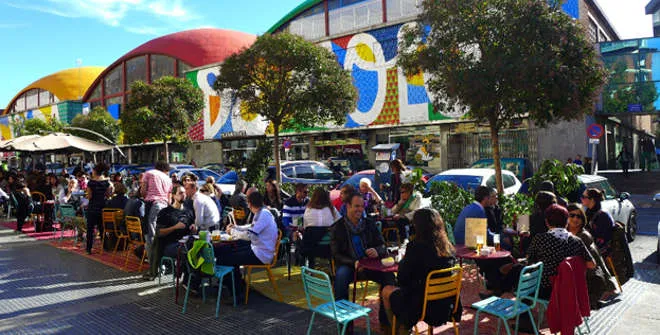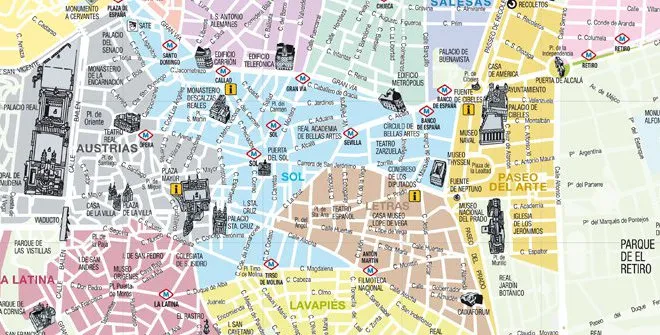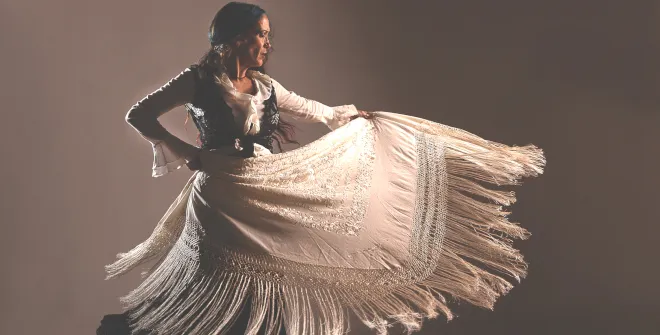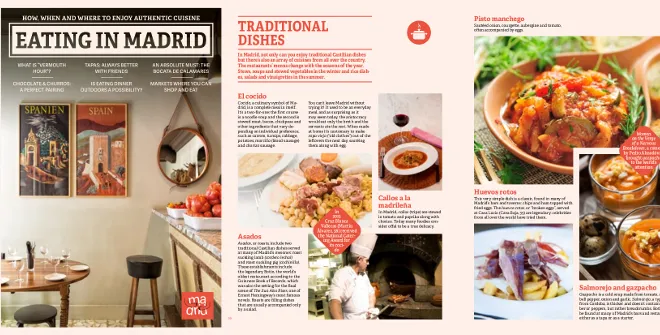La Latina
With El Rastro flea market, the tapas, the festival of La Paloma, Las Vistillas Gardens and much more, this fun-loving area of Madrid is a must for to
La Latina is located in the heart of Madrid, adjacent to other areas of tourist interest, such as the Habsburg, Sol-Gran Vía, Lavapiés and Madrid Río neighbourhoods.
The narrow and winding streets of this irregularly laid-out area, mostly dating back to the Middle Ages, usually lead onto a square. Most of them lay outside the Medieval walled village and provided accommodation to a great many merchants who sold their goods at the market. This commercial tradition still echoes in several street and square names, such as Plaza de la Cebada (Barley Square), where the farmers’ market used to be held, Plaza de los Carros (Carriage Square), Plaza de la Paja (Straw Square), or even El Rastro (owing its name to the blood trail of the old slaughterhouse), the city’s best-known flea market.
The neighbourhood was named after writer and humanist Beatriz Galindo, one of the most relevant personalities of the fifteenth century, who was often referred to as ‘La Latina’ because she was remarkably skilled in Latin. Actually, she was the tutor of Queen Isabella the Catholic and her children. Along with her husband, she established a hospital on Calle Toledo, next to Plaza de la Cebada, which came to be known as ‘Hospital de La Latina’.
Here are some of the top tourist and cultural attractions you shouldn’t miss when visiting La Latina.
Basilica of San Francisco el Grande
Built in the eighteenth century, this basilica boasts one of Europe’s largest domes, which, at 58 metres high and 33 metres in diameter, crowns the rotunda. Its museum houses an important collection of paintings from the eighteenth and nineteenth centuries. It houses works by Zurbarán and Goya, such as the painting, St. Bernardino of Siena preaching to Alfonso V of Aragon by Francisco de Goya, dated 1784. It is home to a stunning 4200 m2 botanical garden, with more than 21 varieties of roses. The garden features a sculpture entitled The Dream of San Isidro by Santiago Costa dating from 1952.
Museum of San Isidro. The Origins of Madrid
The Museum of San Isidro provides an account of Madrid’s archaeological resources and the material, social and spiritual heritage of the various civilisations that have lived here. Plus, there’s the collection of works of art and objects linked to the worship of Saint Isidore the Farmer. The museum’s collection encompasses all cultural periods from the Palaeolithic Age to the present day.
Dating back to the days following the Peninsular War, Puerta de Toledo gate wasn’t the first one with this name to have existed in Madrid: other two used to stand in the same area. Designed by Antonio López Aguado, it was finished in 1827.
Situated at one corner of Plaza de la Paja, this eighteenth-century garden was part of the palace bearing the same name. Today it’s accessible to the public.
These gardens offer magnificent views of Campo del Moro Park, La Almudena Cathedral and Casa de Campo Park. It’s also a great spot to watch spectacular sunsets.
It served as Madrid’s cathedral until the current Catedral de la Almudena (Almudena Cathedral) was finished. Its high altar holds the remains of San Isidore, the patron saint of the city.
Museum of Popular Art and Traditions
The museum displays items related to every-day living and tries to recreate the life of people that produced and used these items. Its current location in an old house, the seat of “La Corrala” (the Cultural Center of Universidad Autónoma de Madrid), makes an interesting fusion between the urban and rural folk traditions.
A chapel founded by Francisco Luján in the 16th century is located in the chancel in the left nave. The remains of his brother Friar Antonio de Luján, the archbishop of Mondoñedo were buried there, but are today held in the National Archaeological Museum.
It is one of the oldest parishes in Madrid. The legend has it that San Isidore the Laborer and Santa María de la Cabeza, parishioners of the church where the saint was later buried, often visited it.
Small garden area in the centre of Madrid that houses a 12th century Christian wall painting, now recovered, which corresponds to part of the original defence route that ran between Puerta de Moros and Puerta Cerrada.
When visiting Madrid, you must definitely stroll down El Rastro flea market, the main feature of this commercial area and one of the city’s top attractions.
Dating back to the Middle Ages, El Rastro (Spanish word for ‘trail’) owes its name to the trail left by the cattle hides dragged from the nearby slaughterhouse along Ribera de Curtidores to the tanneries that used to line up this steep street.
The narrow squares and alleyways of this roughly triangular area, lying within the limits of Calle de Toledo, Calle de Embajadores and Ronda de Toledo, stretch from Plaza de Cascorro to Ribera de Curtidores. Tourists and locals usually venture down streets like San Cayetano, Fray Ceferino González, Carlos Arniches and Mira el Río, or squares such as General Vara de Rey and Campillo del Mundo Nuevo, hunting for bargains.
The most famous antique shops, like Manuel Riestra or Galerías Piquer, are located in this neighborhood. You can also find plenty of shops specialized in vintage and retro decoration like Reno, La Brocanterie, Living Retro, La Recova Vintage, The Point or Antigüedades Palacio.
On Sunday and holiday mornings the streets turn into street markets where you can buy all sorts of products ranging from new and used clothes, jewelry, trinkets and knick-knacks to items from auction houses, old CDs and many more. And after a busy and bustling morning at el Rastro, what can be better than a drink and a snack at one of the traditional taverns like Capricho Extremeño or Taberna donde el Rastro.
La Latina’s dining scene means one thing above all: tapas. This centrally located neighbourhood is a magnet to locals and tourists alike, who happily come here to have their fix of bite-size Spanish food. The area is home to modern bars and traditional taverns, where you can sip your favourite drink (national and imported ales, wines from Spain’s diverse designations of origin or refreshing sangria) while savouring a couple of absolutely delicious tapas. There’s something for everyone; you can choose from a wealth of different recipes of mouth-watering croquettes or go for Madrid’s ubiquitous classics: deep-fried squid, grilled pig’s ear, patatas bravas (cubes of potato in spicy tomato sauce) or boquerones (anchovies) in vinegar, alongside more innovative snacks.
A great deal of hotspots for dining out are to be found in this area, especially on Sundays and holidays, when El Rastro is open. The Cava Alta and Cava Baja streets, which used to be home to inns and guest houses, are now part of a tourist-packed area where you can sample possibly some of Madrid’s best huevos rotos (fried eggs with potato and chorizo sausage).
One of the best terraces in this neighbourhood is El Viajero, a firm favourite in the area, especially in spring and summer, where you can enjoy tapas, wine, beer, and other drinks on the terrace and the roof terrace. You could also check out Rollo Ocho, a modern restaurant with rustic chic decor and a terrace, or Café del Nuncio, one of the most typical cafes in the area.
You can also enjoy the privileged views from the terraces of Las Vistillas. Foodies will have a great time in the squarish area bounded by Carros, Puerta de Moros, Humilladero and San Andrés squares, as well as in Plaza de la Paja or the handsome Calle del Nuncio, where locals meet for tapas.
Bonanno, Delic, La Musa, Tío Timón, Juana la Loca is famous for serving up its speciality Spanish omelette with caramelised onion, Tapioca, Posada de la Villa, Enotaberna del León de Oro, Casa Lucio or La Antoñíta are just a few of the establishments you should not miss on your tapeo tour in La Latina on Sunday or any other day of the week.
The Corral de la Morería, one of the oldest tablaos in the city, has two different gastronomic spaces run by chef David García: Restaurante Corral de la Morería, which has received major gastronomic awards including a Michelin star and the National Gastronomy Award (2018), and Restaurante Tablao, a larger space which also includes a stage for its unique performances.
And if you wish to visit a farmers’ market for a more direct contact with the merchants, you should stop by the Mercado de la Cebada.
La Latina never sleeps. In this pulsing nightlife spot of Madrid, taverns, bars, pubs and nightclubs fill up with revellers partying late into the night.
If you like staying out late or listening to live music, your places to be are Berlín Cabaret, Shoko Madrid, ContraClub, Rincón del Arte Nuevo, Corral de la Morería or the Marula Club Madrid.
If you prefer a more relaxed plan, you can opt for having something to eat and drink at the Café Angélica (Calle Segovia), the Monaguillo or Molar Discos & Libros.
No trip to Madrid would be complete without a taste of the city’s most traditional festivals – verbenas. La Latina’s calendar is packed with celebrations in August. The feasts of Saint Cajetan and Our Lady of the Dove are on 7 and 15 August, respectively, and the verbena of Saint Lawrence, in nearby Lavapiés, takes place on 10 August.
Celebrations in which there will be no lack of garlands and lanterns adorning the streets, open-air concerts, raffles, games of skill and, of course, residents wearing traditional costume. Grab a chulapo cap or a traditional shawl and join in with the people of Madrid to dance our typical dance, the chotis. Other popular festivities to bear in mind which are also held in La Latina, are those of the patron saint of Madrid, San Isidro Labrador, which are held from 11 to 15 May.
La Latina is also a great place to enjoy alternative and family-oriented theatre. Off de La Latina, Teatro de las Aguas and Teseo Teatro are the focal points of this small cultural tour of the area. If you prefer a more classical theatre for all audiences, we recommend Teatro La Latina.












